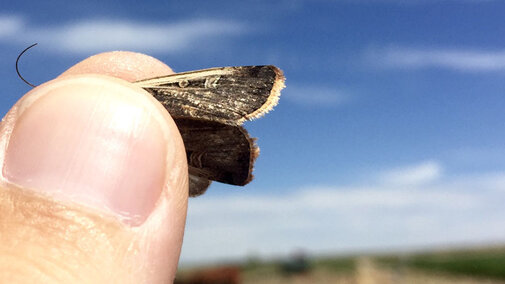Cutworm numbers have been on the increase in western Nebraska over the past several years, and the damage they can cause to dry edible bean fields has bean growers and others in the industry concerned.
Luckily, it is not too difficult or too expensive to control cutworms. But effective control depends on applying insecticide at the right time. And knowing the right time is a matter of monitoring populations of cutworm moths, which lay the eggs that produce the cutworms.
A hands-on workshop scheduled for early March is designed to train people to identify cutworms from all the other moths, and show how to monitor populations. It is organized by UNL Extension Entomologist Jeff Bradshaw, based at the university's Panhandle Research and Extension Center in Scottsbluff.
“Bugeye Workshop: Cutworms and Kin” will be March 11, with one session at 9 a.m. and a repeat session at 2 p.m. It will be in the Bluestem Room of the Panhandle Center. Attendance is limited to 15 people per session, 30 total. Register only at https://go.unl.edu/bugeye. For more information call 308-632-1230.
Bradshaw said conversations with dry bean growers and processors have made him aware of concerns about increasing cutworm numbers, and the associated damage in dry bean fields. Cutworm numbers tend to be cyclical, but their increase is possibly related to weather or climate, according to Bradshaw. The past few winters have been relatively mild in western Nebraska.
The cutworm workshop will be the first in what is planned to be a series of hands-on events designed to train people in the practical identification of insects important to agriculture and natural resources, Bradshaw said. Each workshop will focus on a different group of insects.
Although “Bugeye” is a fun title for the series, Bradshaw says jokingly that workshop participants will spend some time looking at the moths through microscopes and might become temporarily bug-eyed themselves. The workshop is intended to teach:
- the diversity of cutworm moths common to the Nebraska Panhandle;
- the role of cutworm moths in our agroecosystems;
- how to identify common cutworm moths and larvae; and
- the proper setup, deployment, and sampling of cutworm moths, with special focus on the western bean cutworm in dry bean and corn.
The event is free due to support from Trinidad Benham Corp., Kelley Bean Company, and a grant from the U.S. Department of Agriculture National Institute of Food and Agriculture (USDA-NIFA). Bradshaw said the target audience is crop consultants, field scouts, and agriculturalists.
Proper identification and timely management are critical to preventing crop damage. Applying chemicals too early may not be cost-effective and can even be damaging. “You might not have needed to spend the per-acre cost to apply insecticide in the first place, and some insecticides may reduce natural enemies, compounding the problem.”
Keeping track of populations allows farmers to know whether they have crossed a threshold warranting treatment at a given time. Cutworm moth populations generally peak in July, and 10 to 20 days afterward generally is the sweet spot for treatment, according to Bradshaw.
The March workshop will cover monitoring technologies, including newer trapping systems that count the moths automatically. Bradshaw hopes the workshop also serves as a training event for a monitoring network that he hopes to establish, using the modern traps.

